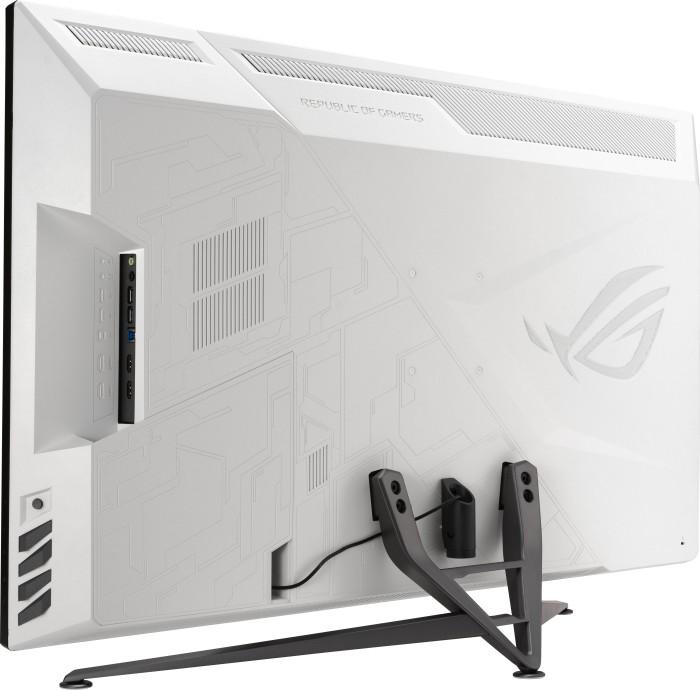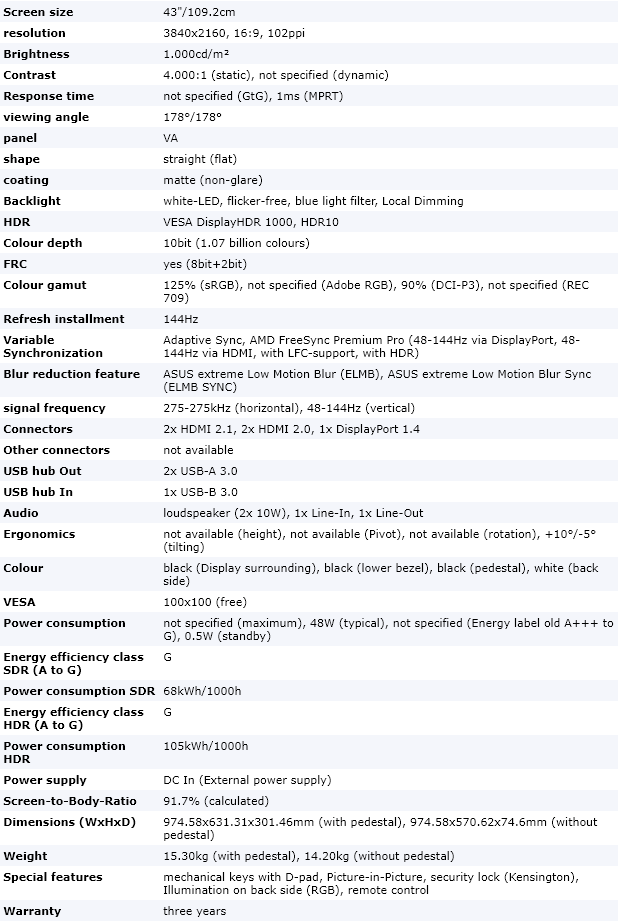A Spec or two
ASUSXG43UQ
The XG43UQ has a screen diagonal of 43 inches and a resolution of 3840 x 2160 pixels on its UHD screen. The built-in VA panel measures 43 inches diagonally and achieves a maximum refresh rate of 144 Hz Originally, this was to be implemented primarily via a DisplayPort 1.4 with DSC technology ("Display Stream Compression"). ASUS however has implemented there two HDMI 2.1 interfaces onboard rocking UHD/120Hz on your console as well. HDMI 2.0 is available in the same number as a bonus.
On the desk
The front and back of the ASUS ROG Strix XG43UQ are all black, with the front being all black and the back being all white. The legs of the tabletop stand are cast at a shallower angle than previous-gen ROG stands, leaving more room for peripherals and accessories. The stand offers tilt and height adjustments, facilitating correct viewing and seating positions for prolonged play. A couple of USB 3.0 ports ready for peripherals, and an earphone jack for conveniently tethering a set of cans.
Finally, as we navigate through the menus, we come across the traditional pre-set profiles, the frames per second counter, viewfinders, timers, dimming to compensate for the lack of FALD, and Shadow Boost to boost the perception of contrast and black levels.
- Dimensions: 43 inches
- Panel: VA, anti-glare
- Resolution: 4K 16: 9 (3840×2160)
- Refresh rate: 144 Hz DisplayPort 1.4, 120 Hz HDMI 2.1 (console)
- Response time: 1 ms MPRT
- Lighting: Direct LED with typical luminance 750 cd / m2 and peak 1000 cd / m2
- HDR: HDR10
- Contrast: 4000:1
- Color range: 10 bits (1.07 billion colors), sRGB 125%, DCI-P3 90%
- Tecnologie gaming: FreeSync Premium Pro (VRR), G-Sync compatibility, Console Mode (4K 120Hz)
- Audio: 2 x 10W speakers
- Connectivity: 1x DisplayPort 1.4 (4K 144 Hz – High Bit Rate 3), 2x HDMI 2.1 (HDMI2.1 4K 120Hz – Console Mode), 2X HDMI 2.0, 2x USB 3.0 Type-A, 1x USB Type-C, jack 3.5 mm cuffie/stereo
- Ergonomics: tilt (+10/-5)
- Power supply / consumption: external / 48 W
- Vesa Mount: 100x100mm
- Weight: 15.3 kg
- Dimensions: 974.58 x 631.31 x 301.5 mm (con stand)
HDMI 2.1 is important, not so much for PC, but it allows diverting any chroma subsampling issues on that connection. Of course on PC, connecting through Display port 1.4 solves the issue. If you have a competent video card, the monitor should be connected via the single DisplayPort input for A 4:4:4 color setup. For all of the four HDMI ports, two are HDMI 2.1 compatible. Consoles and graphics cards from Nvidia and AMD that support HDMI 2.1, which supports 4K/120Hz, as well as adaptive sync known as "HDMI VRR," are among the latest products to incorporate this technology.
| Video Format | HDMI Version / Maximum Data Rate | |||||
|---|---|---|---|---|---|---|
| Shorthand | Resolution | Refresh | Data Rate | 1.3 / 1.4b | 2.0 / 2.0b | 2.1 |
| Rate (Hz) | Required | 8.16 Gbit/s | 14.4 Gbit/s | 42.6 Gbit/s | ||
| 1080p | 1920/1080 | 30 | 1.58 Gbit/s | Yes | Yes | Yes |
| 60 | 3.20 Gbit/s | Yes | Yes | Yes | ||
| 120 | 6.59 Gbit/s | Yes | Yes | Yes | ||
| 144 | 8.00 Gbit/s | Yes | Yes | Yes | ||
| 240 | 14.00 Gbit/s | compression RGB | Yes | Yes | ||
| 1440p | 2560/1440 | 30 | 2.78 Gbit/s | Yes | Yes | Yes |
| 60 | 5.63 Gbit/s | Yes | Yes | Yes | ||
| 75 | 7.09 Gbit/s | Yes | Yes | Yes | ||
| 120 | 11.59 Gbit/s | compression RGB | Yes | Yes | ||
| 144 | 14.08 Gbit/s | compression RGB | Yes | Yes | ||
| 240 | 24.62 Gbit/s | No | compression RGB | Yes | ||
| 4K | 3840/2160 | 30 | 6.18 Gbit/s | Yes | Yes | Yes |
| 60 | 12.54 Gbit/s | compression RGB | Yes | Yes | ||
| 75 | 15.79 Gbit/s | compression RGB | compression RGB | Yes | ||
| 120 | 25.82 Gbit/s | No | compression RGB | Yes | ||
| 144 | 31.35 Gbit/s | No | No | Yes | ||
| 240 | 54.84 Gbit/s | No | No | compression DSC | ||
| 5K | 5120/2880 | 30 | 10.94 Gbit/s | compression RGB | Yes | Yes |
| 60 | 22.18 Gbit/s | No | compression RGB | Yes | ||
| 120 | 45.66 Gbit/s | No | No | compression DSC | ||
| 8K | 7680/4320 | 30 | 24.48 Gbit/s | No | compression RGB | Yes |
| 60 | 49.65 Gbit/s | No | No | compression DSC | ||
| 120 | 102.2 Gbit/s | No | No | compression DSC | ||
| HDMI Version | 1.3/1.4b | 2.0 /2.0b | 2.1 | |||
Display Stream Compression (also known as DSC) is supported by the DisplayPort connection, which means we can achieve full 4K 144Hz RGB support without the need for chroma subsampling. A significant issue with the first generation of 4K 144Hz displays, although it has since been fixed. With the XG43UQ, you can get 8-bit+FRC at 4K 144Hz or native 10-bit at up to 4K 120Hz on a single channel. Console owners should choose HDMI 2.1 of course.
Bonus ROG features
GamePlus is a set of four on-screen tools. The Crosshair option allows you to choose from four different crosshairs overlaid in the center of the screen, allowing you to shoot from the hip more accurately when the game play doesn’t offer a marker. The Timer is a user-customizable, movable countdown timer, letting you keep track of time-based events. For performance-tuning, a histogram FPS counter is also included. Lastly, the Display Alignment overlay aids the process of aligning multi-monitor setups. GameVisual is a set of color profile presets. Easily accessible through the press of a button, there are a total of eight presets to choose.
The modes are as follows:
- RTS/RPG mode: Enhanced sharpness and color clarity
- sRGB mode: Optimizes colors for editing and web use
- Racing mode: Optimizes colors for fast-moving games, sets gamma to 2.2 and color temperature to 6500K
- Cinema mode: Enhances contrast and increases color saturation, for more vivid videos
- FPS mode: Increases brightness and contrast, tweaks color saturation to bring out green landscapes and blue seas
- User mode: Customize your own profile
HDR
The ASUS ROG XG43UQ is certified by the VESA DisplayHDR 1000 standard. The key argument for selecting the XG43UQ over other gaming monitors is just that and 144 HZ really as it should result in significantly higher HDR image quality than that of a typical display in most situations. In order for this HDR mode to work properly, the maximum brightness of the screen must be greater than 1000cd/m2.



